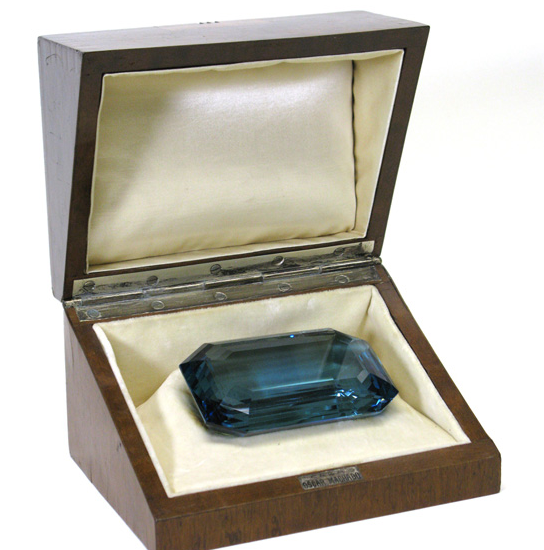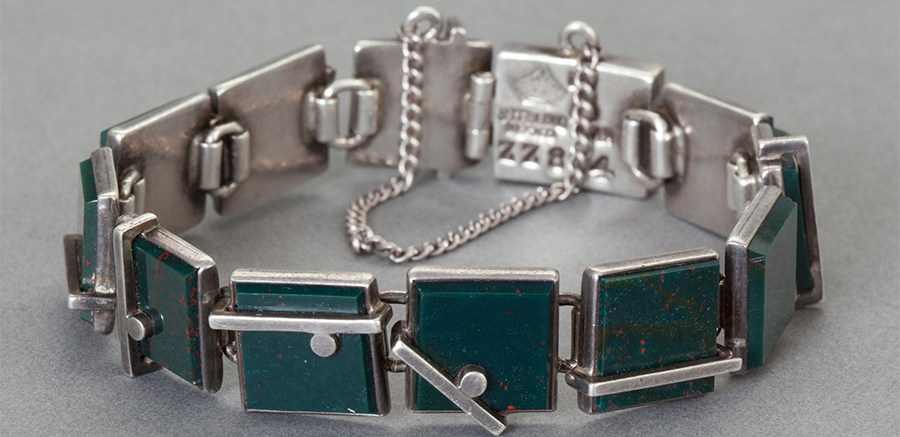March Birthstone
Aquamarine & Bloodstone
Aquamarine and bloodstone are the two birthstones for March. One evokes blue skies and calming waters while the other represents health and strength. Learn more about these two March birthstones and where they can be found.

The two birthstones for March, aquamarine and bloodstone, are very different from one another in terms of look, but they are both known for guarding against harm. The sea’s hues are conjured up by the aquamarine birthstone. Faceted aquamarines range in colour from deep green-blue to light, somewhat greenish blue hues, and are frequently devoid of impurities and as pure as water, signifying the purity of the spirit and soul. The birthstone known as “bloodstone” is often a dark-green cabochon with red patches of iron oxide, which symbolises the “blood” that bestows power and health upon the wearer. Continue reading to discover more about these two birthstones for March, including their origins and meanings.
Aquamarine Meaning & History
Ancient mariners believed the diamond would calm the waves and keep sailors safe at sea because the term aquamarine is derived from the Latin for seawater. It was also believed that people born in March will have happy marriages. Beryl was thought to provide wearers with defence against adversaries in conflict and legal proceedings. Additionally, it was believed to sharpen the mind and make the wearer more amicable and impregnable.
In addition to being the March birthstone, aquamarine is also presented as a gift on the 19th wedding anniversary. For instance, the Brazilian government awarded First Lady Eleanor Roosevelt a 1,298 carat (ct) dark blue rectangular step cut aquamarine in 1936.It was the largest of two stones that were faceted from an astounding 2.9 pounds (1.3 kilogrammes) of aquamarine rough. The Franklin D. Roosevelt Presidential Library and Museum in Hyde Park, New York, is where it is now kept. The 10,363 ct (or 4.6 pounds) Dom Pedro Aquamarine, regarded as the world’s largest faceted aquamarine, is a well-known exhibit at the Smithsonian Institution. Berndt Munsteiner, a renowned German lapidary, created the about 14-inch (36-centimeter) tall obelisk using the fantasy cut technique

Aquamarine Source
For the past 200 years, the Brazilian state of Minas Gerais has been a significant supply of aquamarine. A variety of landscapes may be found there, with rocky hills, rivers, and scrub brush dominating the centre and eastern sections, savannahs, woods, and streams dotting the west, and rolling hills of lush greenery extending southward. In the eastern part of the state, close to Teófilo Otoni, a gem centre, aquamarines are discovered in primary (hard rock) and secondary (weathered) pegmatite deposits.
Additionally, aquamarine can be discovered high in Pakistan’s Karakorum foothills. Miners must ascend arduous pathways to heights of 9,800 to 13,000+ feet (3,000 to more than 4,000 metres) and work the sides of treacherous cliffs in order to reach the deposits. Small villages, teeming rivers, and fertile valleys can be found below this harsh, stony surface. This region’s aquamarine has been described as “water clear.”

Along with other countries in Africa, Kenya, Madagascar, Nigeria, Zambia, and Mozambique all have aquamarine mines. The Mount Antero region of Colorado (the state jewel), as well as the counties of Riverside and San Diego in California, are examples of U.S. sources. Aquamarine has also been discovered in a number of other nations, including China, Myanmar, Russia, and Ukraine.
Aquamarine Care & Cleaning
This March birthstone has a Mohs hardness of 7.5-8, making it strong enough for daily wear. Maintaining the gem is simple. To clean the area where dirt can collect behind the birthstone, use warm water, mild dish soap, and a toothbrush. As long as the gem has no cracks or liquid inclusions, using steam or ultrasonic cleaners is typically safe.

Bloodstone Meaning & History
Bloodstone, often referred to as heliotrope, is a type of chalcedony (cryptocrystalline quartz) that is typically a dark green jasper with crimson inclusions of iron oxides, particularly hematite, that ranges in transparency from semi-transparent to opaque. Heliotrope, another name for bloodstone, is derived from the Greek verb meaning “to turn the sun.” These March birthstones were once thought to turn the sun crimson when submerged in water. The term “bloodstone” comes from the idea that some people hold that the colour pattern has spiritual meaning and symbolises the blood of Christ.
This March birthstone has been given several metaphysical characteristics. They consist of boosting power, granting invisibility, and maintaining youth and health.
Since the bloodstone birthstone is prized by athletes and other people who desire to increase their strength, many people today think that it is a lucky charm. Fine bloodstones can still be ground into a powder and used as an aphrodisiac in India today.
Even though the aquamarine March birthstone is more beautiful, bloodstone is prized for its unique qualities. Although there are some stunning specimens of faceted bloodstones, most bloodstones used as jewels are cut as cabochons.

Bloodstone Source
Indian bloodstone makes up the majority of the market nowadays. The bloodstone birthstone, however, is also found in several areas of Brazil, Australia, China, and the United States, to name a few. Bloodstone can be found as pebbles in riverbeds, filling cracks or voids in other rocks.

Bloodstone Care & Cleaning
You can easily clean your bloodstone birthstone at home with warm, soapy water and a soft brush. It’s critical to keep your bloodstone away from corrosive substances and highly hot environments. Use a fresh, gentle cloth to dry this March birthstone. It’s crucial to store your bloodstone birthstone in a soft cloth to prevent scratching (the stone is 6.5-7 on the Mohs scale).

